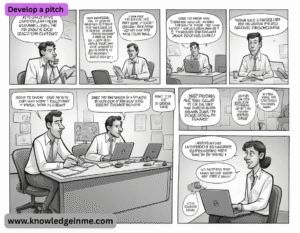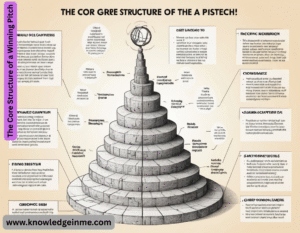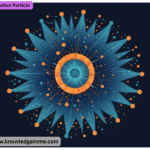Develop a pitch Certainly! To craft a compelling pitch, it’s essential to be clear, concise, and persuasive. Below is a structured approach to developing your pitch, whether it’s for a product, service, startup, or idea.
Hook (Grab Attention)
Example:
- “Did you know that 80% of small businesses struggle with inefficient inventory management, costing them thousands annually?”
Problem Statement
- Define the pain point or gap your audience f
Example:
- “Managing inventory manually is time-consuming, error-prone, and leads to overstocking or stockouts—hurting profits and customer trust.”
Solution
- Introduce your product/service as the answer. Keep it simple.
Example:
- Develop a pitch “That’s why we created StockEase, an AI-powered inventory platform that automates tracking, predicts demand, and saves businesses 30+ hours a month.”
How It Works
- Briefly explain the key features or process.
Example:
- “StockEase syncs with your POS, analyzes sales trends, and sends smart reorder alerts—all in real time.”
Unique Value Proposition (UVP)
- What sets you apart? Highlight competitive advantages.
Example:
- “Unlike other tools, StockEase offers:
- One-click integration
- Predictive analytics
- 24/7 customer support”
Traction/Proof
- Add credibility with metrics, testimonials, or achievements.
Example:
- “Piloted with 50+ businesses, we’ve reduced inventory costs by 40% and boosted sales by 15%.”
Call to Action (CTA
- End with a clear next step.
Example:
- “Join our beta waitlist today and get 3 months free!”
Pitch Example (Elevator Pitch – 30 Seconds):
- 80% of small businesses lose money due to poor inventory management. StockEase fixes this with AI-driven automation that predicts demand, prevents stockouts, and saves time. Already proven to cut costs by 40%, our platform integrates seamlessly and comes with dedicated support. Let’s schedule a demo and show you how StockEase can transform your operations!”*
Tips for Success:
- Develop a pitch Tailor your pitch to your audience (investors? customers? partners?).
- Keep it concise—avoid jargon.
- Show passion—energy builds confidence.
- Practice until it feels natural.
Choose Your Pitch Type
- Different scenarios require different pitches. Here are the most common types:
A. Elevator Pitch (30 sec – 1 min)
- Goal: Spark interest quickly.
Structure:
- Hook – Grab attention.
- Problem – What pain point exists?
- Solution – Your product/service.
- Why You? – Key differentiator.
- CTA – What’s the next step?
Example (Startup):
- “Did you know food delivery apps take 30% of restaurant profits? Feast Direct *is a zero-commission platform connecting diners directly with local eateries. We’ve on boarded 200+ restaurants in 3 months—helping them keep 100% of their revenue. Want to join the movement?”*
Investor Pitch (3–5 min, e.g., for a pitch deck)
- Goal: Secure funding by proving market potential.
- Structure (Classic 10-Slide Framework):
- Title Slide – Company name, logo, tagline.
- Problem – The pain point.
- Solution – Your product.
- Market Size – TAM, SAM, SOM.
- Business Model – How you make money.
- Traction – Customers, revenue, growth.
- Competition – Differentiation.
- Team – Key members.
- Ask – Funding amount & use of funds.
- Vision – Long-term impact.
Example (Slide 3 – Solution):
- Develop a pitch “Our AI tool DocuSense *automates contract reviews, cutting legal costs by 70% and reducing errors by 90%. Enterprises like XYZ Corp already save $500K/year with us.”*
Sales Pitch (2–3 min, for customers)
- Goal: Close a sale or demo.
Structure:
- Hook – Relatable problem.
- Agitate – Why it’s urgent.
- Solution – Your product’s benefits.
- Social Proof – Testimonials/case studies.
- CTA – Discount, trial, or demo.
Example (SaaS):
- “Tired of losing leads due to slow follow-ups? ReplyGenius *automates personalized email responses within 5 minutes, boosting conversions by 40%. 500+ sales teams rely on us—try it free for 14 days!”*
Advanced Pitch Techniques
A. The Pixar Storytelling Formula
- Make your pitch emotional and memorable:
- Once upon a time… (Context)
- Every day… (Status quo)
- One day… (Catalyst)
- Because of that… (Struggle)
- Until finally… (Solution)
Example:
- “Small bakery owners spend hours manually tracking orders and often mess up deliveries. One day, Maria lost a $5K catering deal due to a missed email. That’s why we built BakeryFlow—*an all-in-one order manager that saved her 15 hours/week and doubled her revenue.”*
The “3 Why’s” Method
- Answer these to create depth:
- Why this problem? (Market need)
- Why this solution? (Your USP)
- Why now? (Market timing)
Example (Fintech Startup):
- Develop a pitch “Banks charge SMEs 3% transaction fees— why? Because legacy systems are expensive. Our blockchain solution cuts fees to 0.5%— why us? We’re the only ones with patent-pending tech. And why now?
The “Drop the Mic” Close
End with a bold statement:
- “We’re not just another app—we’re the Uber for healthcare staffing and hospitals are begging for this.”
- “This isn’t just a product—it’s a $10B market disruption waiting to happen.”
Common Pitch Mistakes to Avoid
- Too much jargon → Keep it simple.
- No clear CTA → Always say what you want.
- Ignoring competition → Acknowledge rivals, then crush them.
- Being boring → Energy = memorability.
Perfect Your Delivery
- Practice until it’s natural (record yourself!).
- Body language matters—stand tall, eye contact, smile.
- Pace yourself—don’t rush; pause for impact.
. The Core Structure of a Winning Pitch
- Every great pitch follows a narrative arc that moves the audience from curiosity to conviction.
A. The 5-Part Pitch Blueprint
- Hook (The Attention-Grabber)
- Start with a bold stat, question, or story.
- Example: “Every year, businesses lose $1.7 trillion due to poor workplace communication.”
Problem (The Pain Point)
- Define the problem emotionally—make them feel it.
- Example: *”Teams waste 20+ hours a week on misaligned emails, missed updates, and chaotic Slack threads.”*
Solution (Your Magic Bullet)
- Present your product/service as the obvious answer.
- Example: *”Meet FlowSync, the AI-powered platform that automates team updates and cuts wasted time by 80%.”*
Proof (Why Trust You?)
- Use traction, testimonials, or data.
- Example: *”Used by Google, Airbnb, and 500+ teams—saving $4M in productivity costs last year.”*
CTA (The Ask)
- Be specific—what do you want?
- Example: “Let’s onboard your team for a free trial—just say ‘yes’.”
Psychological Triggers to Make Your Pitch Irresistible
- Use cognitive biases to influence decisions:
Anchoring
- Our enterprise plan is $1,000/month… but today, you can lock in $499.”*
Storyselling (Not Just Selling)
- “Sarah, a startup founder, was drowning in admin work—until she used TaskMaster and got 15 hours back per week.”
The Steve Jobs Pitch Technique (Apple-Style Persuasion)
- Jobs’ legendary pitches followed this pattern:
- “This is the status quo.” (“Phones are complicated.”)
- “But here’s the problem.” (“They’re hard to use.”)
- “What if there was a better way?” (“Introducing iPhone—it just works.”)
- “This changes everything.” (“Today, Apple reinvents the phone.”)
Apply it to your pitch:
- “Accounting software is stuck in the 90s… until now.”
The “Pitch Hack” – The One-Sentence Rule
- If you can’t explain your business in one sentence, refine it.
- Before: “We’re a SaaS platform leveraging AI to optimize workflows.”
- After: *”We save teams 10+ hours a week by automating busywork.”*






